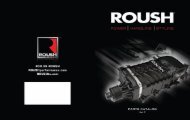2005 Towing Guide - Ford Fleet - Ford Motor Company
2005 Towing Guide - Ford Fleet - Ford Motor Company
2005 Towing Guide - Ford Fleet - Ford Motor Company
Create successful ePaper yourself
Turn your PDF publications into a flip-book with our unique Google optimized e-Paper software.
THINGS TO<br />
KNOW<br />
Before You Buy<br />
If you are selecting a vehicle that will be used for<br />
towing, you should determine the approximate<br />
weight of the trailer you intend to tow,<br />
including the weight of any additional cargo and<br />
fluids that you will be carrying in the trailer.<br />
Also be sure the vehicle has the proper optional<br />
equipment (see page 15).<br />
Note: Performance can be severely compromised in hilly<br />
terrain when minimum acceptable powertrain combination<br />
is selected. Consider purchasing a vehicle with a more<br />
powerful engine.<br />
BRAKES<br />
Many states require a separate braking system on<br />
trailers with a loaded weight of more than 1,500<br />
pounds. For your safety, <strong>Ford</strong> <strong>Motor</strong> <strong>Company</strong><br />
recommends that a separate functional brake<br />
system be used on any towed vehicle, including<br />
those dolly-towed or towbar-towed. There are<br />
two basic types of brake systems designed to<br />
activate trailer brakes:<br />
1. Electronically Controlled Brakes usually<br />
provide automatic and manual control of<br />
trailer brakes. They require that the tow<br />
vehicle be equipped with a controlling device<br />
and additional wiring for electrical power.<br />
These brakes typically have a control box<br />
installed within reach of the driver and can be<br />
applied manually or automatically.<br />
2. Surge Brakes are independent hydraulic brakes<br />
activated by a master cylinder at the junction of<br />
the hitch and trailer tongue. They are not<br />
controlled by the hydraulic fluid in the tow<br />
vehicle’s brake system, and the tow vehicle’s<br />
hydraulic system should never be connected<br />
directly to the trailer’s hydraulic system.<br />
Be sure your trailer brakes conform to all<br />
applicable state regulations. See Trailering Tips on<br />
back cover for additional braking information.<br />
TRAILER LAMPS<br />
Make sure the trailer is equipped with lights that<br />
conform to all applicable government<br />
regulations. The trailer lighting system should<br />
not be connected directly to the lighting system<br />
of the vehicle. See a local recreational vehicle<br />
dealer or rental trailer agency for correct wiring<br />
and relays for the trailer and heavy-duty flashers.<br />
BEFORE<br />
YOU TOW<br />
After You Buy<br />
Before heading out on a trip, check your vehicle’s Owner <strong>Guide</strong><br />
for break-in and severe-duty maintenance schedules (do not tow<br />
a trailer until your vehicle has been driven at least 500 miles).<br />
Be sure to have your fully loaded vehicle (including passengers)<br />
and trailer weighed so as not to exceed critical weight limits (see<br />
page 26). If any of these limits are exceeded, cargo should be<br />
removed from the vehicle and/or trailer until all weights are<br />
within the specified limits.<br />
SAFETY CHAINS<br />
Always use safety chains when towing. Safety chains are used<br />
to retain connection between the towing and towed vehicle in<br />
the event of separation of the trailer coupling or ball.<br />
Cross chains under the trailer tongue to prevent the tongue<br />
from contacting the ground if a separation occurs. Allow only<br />
enough slack to permit full turning – be sure they don’t drag<br />
on the pavement.<br />
See your vehicle’s Owner <strong>Guide</strong> for safety chain attachment<br />
information.<br />
When using a frame-mounted trailer hitch, attach the safety<br />
chains to the frame-mounted hitch using the<br />
recommendations supplied by the hitch manufacturer.<br />
For rental trailers, follow rental agency instructions for<br />
hookup of safety chains.<br />
TRAILER WIRING HARNESS<br />
Some vehicles equipped with a factory-installed Trailer <strong>Towing</strong><br />
Package include a trailer wiring harness and a wiring kit.<br />
This kit includes one or more jumper harnesses (to connect<br />
to your trailer wiring connector) and installation instructions.<br />
Refer to page 14 for standard and optional wiring harness usage.<br />
23




